You may not find this terribly rewarding unless you're included here, so this is a good time for casual and random browsers to turn back before they get too caught up in the sweep and majesty of the proceedings and can't let go.
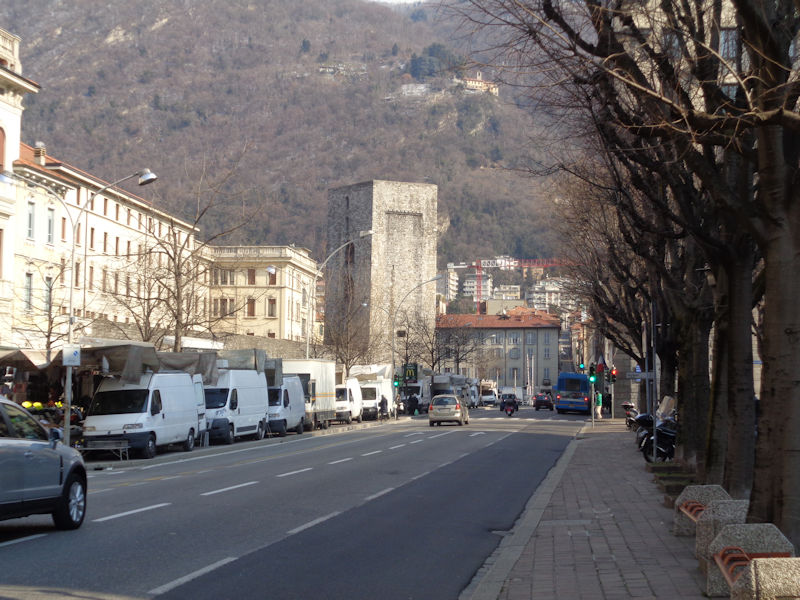
We're staying in Venegono Superiore, 16km to the west, near Varese, and on 27 February 2018 we're here to visit Como for the first time in nearly 20 years. Who knows what major changes might have taken place since then? That's the Torre San Vitale, one of the three remaining defensive towers along the southern city wall. It's said that 70% of the medieval perimeter walls still exist.

And that's the central tower, the 40m Porta Torre, built in 1192 as the main gateway into the city, facing in the direction of Milan.

Just inside the entrance to the historic walled city, this is the Largo Miglio leading towards the Lago di Como. Como is a sizable town of about 85,000 residents, but the historical centre, within the medieval walls and with traffic restrictions, comprises a Roman-style grid of only 850m long, from here to the lake, by 550m wide.
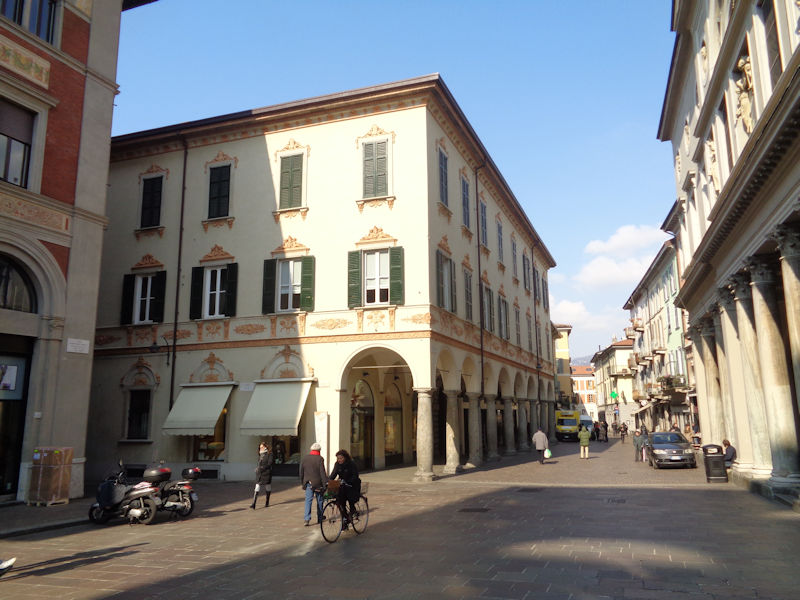
The Largo Miglio becomes the Via Cesare Cantù, named for a prolific 19th century historian, known for an early history of the Diocese of Como and a 72-volume 'Universal History' (1840-1847).

A look back at the Porta Torre. There were Bronze Age settlements in the hills around the lake, and the Insubri Gauls had a fortified place near here, but according to Livy the Romans took over the region in 196 BC. After the settlement here was destroyed in 90 BC by German raiders from the mountains to the north, the Romans began fortifications and infrastructure for a new settlement, called Novum Comum, but it was Julius Caesar in 59 BC who drained the swamps along this end of the lake and refounded the colony with new walls just where the square of existing medieval walls still exists.

Como became the seat of a Catholic diocese in the 4th century and a free commune in the 11th century, but after the so-called 'Ten Years War' with Milan, the city was destroyed in 1127 and prevented by the Milanese from refortifying it. When Frederick I Barbarossa showed up on his first of six 'descents' into Italy, in 1154, the Comaschi joined the other cities that supported the new Holy Roman Emperor in his wars with Milan, and in 1162, following a successful imperial siege, they convinced Frederick to plunder and destroy Milan entirely, which he did. With Barbarossa's authorization, cities like Como and Lodi were able to begin rebuilding their city walls and defensive towers. In 1176, after Barbarossa lost the battle of Legnano to the Lombard League, he was able to find shelter in Como.

Through labyrinthine streets to the Basilica di San Fedele

The Basilica di San Fedele, dedicated to Saint Fidelis of Como, is a Romanesque church begun in 1120 on the site of a 7th century church dedicated to St Euphemia, who got eaten by a lion in the arena of Chalcedon in 303. The structure and interior of the church are remarkable and in good condition, but the 'neo-Romanesque' façade was completely redone in 1914, as was the top half of the belltower.

The central apse, with similar-sized apses in both arms of the transept

Just inside the front door, this is an interesting triptych of the enthroned Madonna with child, flanked by Sebastian with his arrows and Rocco with his plague buboes, attributed to Giovanni Andrea de Magistris, early 16th century.
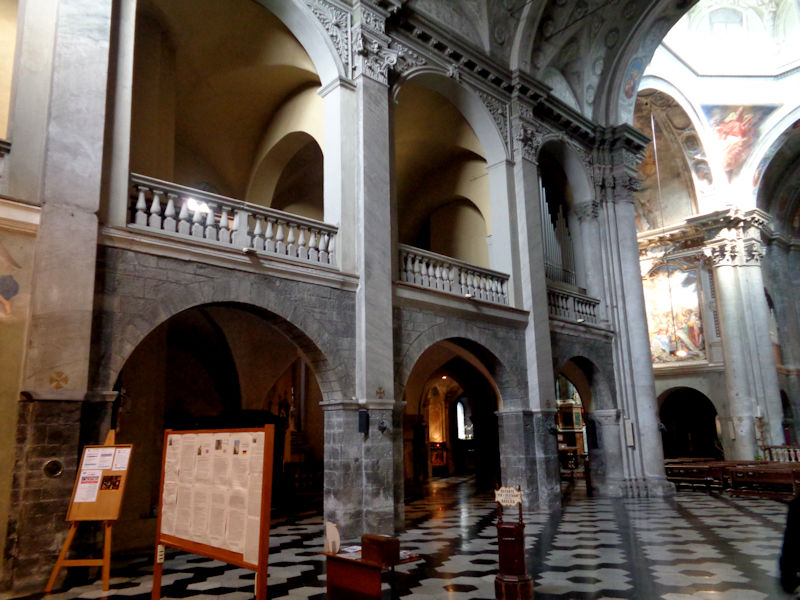
The women's gallery
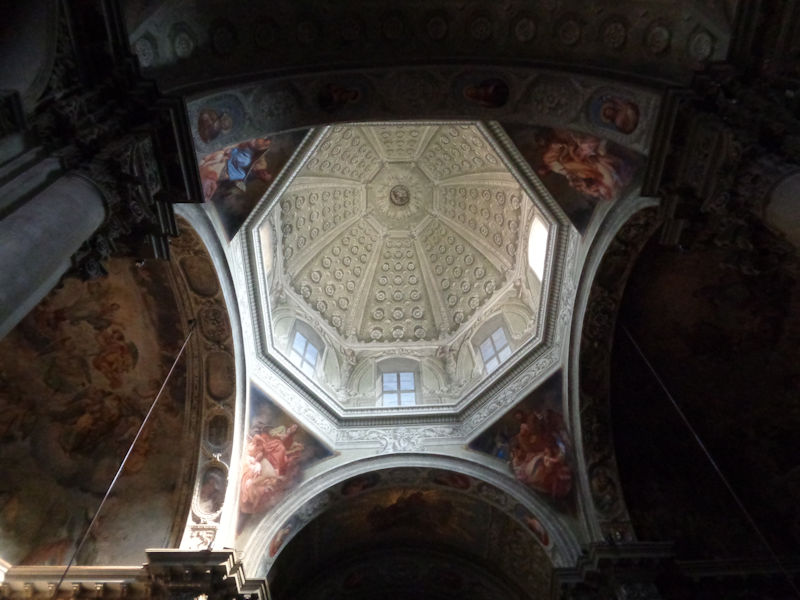
A trompe-l'oeil dome

The main altar on a raised presbytery -- under the altar is the 'Gothic Ark of St Fidelis' (we're told), presumably with relics in it.

In the left transept, the Cappella della Beata Vergine della Purificazione, Chapel of the Blessed Virgin Purified, with a gilded wooden statue from 1665.

In one of the two half-ambulatories behind the central apse, here's a grim reminder of the sinner's fate. (It looks like, if you dropped a euro into the slot, the figures would all writhe around for 30 seconds.)
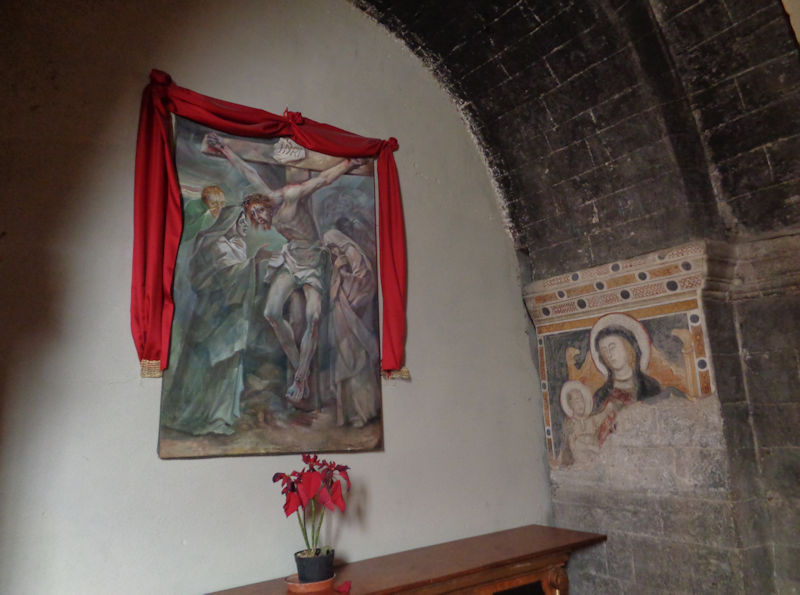
This one is unlabeled. Fidelis himself was an important cult figure in this region, one of the soldier/saints associated with the 'Theban Legion', which had turned Christian and deserted the Roman army during one of the periods of persecution, but who were caught and executed in Como in ca. 304. Miracles were claimed for his relics and tomb in Como as early as the 500s -- supposedly, his relics were removed to Arona during the 12th century war between Como and Milan, then subsequently shared out to all the claimants.

The Piazza San Fedele outside the basilica, site of the medieval corn market

On the Via Vittorio Emanuele II, searching for the cathedral. This looks very promising.

The southern side of the Duomo di Como (the former 'House of Fascism' is just behind it, happily out of sight)

The Piazza del Duomo

Alongside the Cathedral is the medieval Broletto, the common medieval northern Italian assembly place for the voting citizens with city administrative offices upstairs. The Broletto here was begun in 1215.

The Gothic Como Cathedral, or Cattedrale di Santa Maria Assunta, or Duomo di Como, was begun in 1396 on the site of the earlier Romanesque Cathedral of Santa Maria Maggiore -- it was completed in 1770 with a Rococo cupola by Juvara. The façade was put on between 1457 and 1498, and the seated statues on either side of the portal represent Pliny the Elder and Pliny the Younger, both of whom were natives of Como.

The Broletto is out of symmetry -- the balcony, for example, is off centre -- because the new 15th century Duomo was built from the back end forward and wider than the pre-existing building. There's conjecture that the intention was that, when the time came, the Broletto would be knocked down entirely, but in the end the designers decided to save what could be saved of it, along with the Civic Tower.

A Latin cross with a nave and two side aisles, with Juvara's dome 75m high over the crossing. The transept and the apses and choir are from the Renaissance period.

The front portal of the Duomo, with the tapestry hangings all along the nave

An elegant baptismal font

Towards the choir in the central apse

The hanging tapestries are said to be made from cartoons by Giuseppe Arcimboldo, the 16th century fruits and vegetables guy.

An altar in an apse in one arm of the transept

In the other arm of the transept

The central apse

In the choir of the central apse, from 1317


-- Thanks for stopping in.

The Broletto attached to the northern wall of the Duomo. The floor is lower because that was the street level when it was built; subsequent rises in the lake level, caused by Visconti fiddling over by Lecco with the outflow to the river Adda in 1333, required the raising of the street level. The far end of the Broletto houses the Tourist Information Office.

The Palazzo Pretorio was originally connected to the Broletto by a portico that was removed in 1515. The Broletto was partially destroyed by a fire occasioned by downtown wars between the rival Rusconi and Vitani families; during the repairs, the floor of the Broletto was brought to the newer, higher level, but has since been returned to its original state. (The Ghibelline family of Rusca or Rusconi was dominant in 13th century Como, though municipal autonomy was maintained until Milan under Azzone Visconti took over direct control of Como in 1335.)

The Church of San Giacomo from the 11th century was originally longer and reached to the then-Broletto.
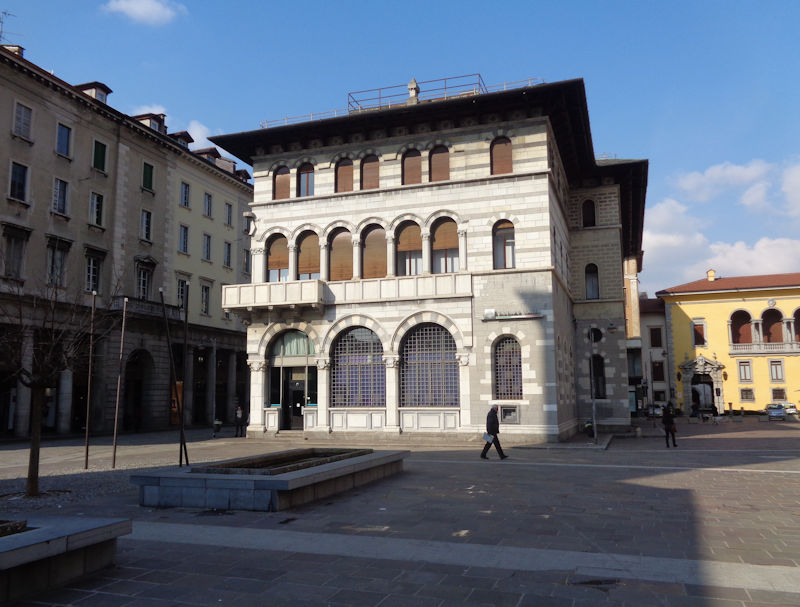
The Rusca lords of Como created a citadel within the walled city, in around 1250, called the Castello della Torre Rotonda, by building another wall in the centre city to help in controling the population, and when the Visconti took over in 1335 they extended and further fortified it to embrace the Duomo, Broletto, Pretorio, and San Giacomo church northward to include the militarized port area. The remains of those intra-city fortifications were removed in 1811.

The Cathedral, Broletto, and its Civic Tower

The nearby Bishop's Palace

To the Lago di Como, looking north leading towards the historically strategic Ticino valleys

The Piazza Cavour, looking 120m diagonally across it.

Lake Como and the Alpine foothills

The funicular up to Brunate

Across the port, that's the the Tempio Voltiano, completed in 1927 to mark the centenary of the death of Como's own Alessandro Volta (1745-1827), inventor of the volt. And of the electrical battery. And he discovered methane.

The Arrow of the Valleys coming back from a run up the lake

We're looking for a small and unassuming restaurant -- this is the Piazza Alessandro Volta, and that's his statue on the right.

After the French occupation following the Battle of Marignano (1515) in the Wars of the League of Cambrai, the Spanish regained Como in 1521 and sacked the city, and in 1527 destroyed the historic fortification of the Baradello Castle on the hilltop just above Como's southwest corner.

Mr Volta

Having found our little trattoria, presently we're looking for the pinacoteca.
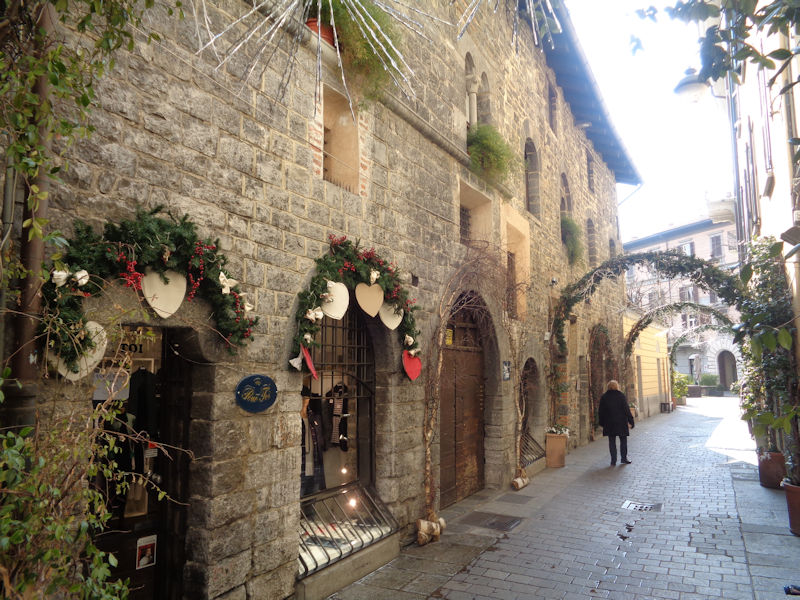
Como street scene

Another

An elegant archway into the courtyard

A basic archway into the courtyard

A tight squeeze

Behold, the Pinacoteca Civica in the Palazzo Volpi from the 17th century, with a strong medieval and Renaissance collection of mostly local art, but with upper floors continuing to modern times.

A good start to our visit


A comfortable and well laid-out gallery, with panel explanations only in Italian but with info sheets in English for most of the rooms.
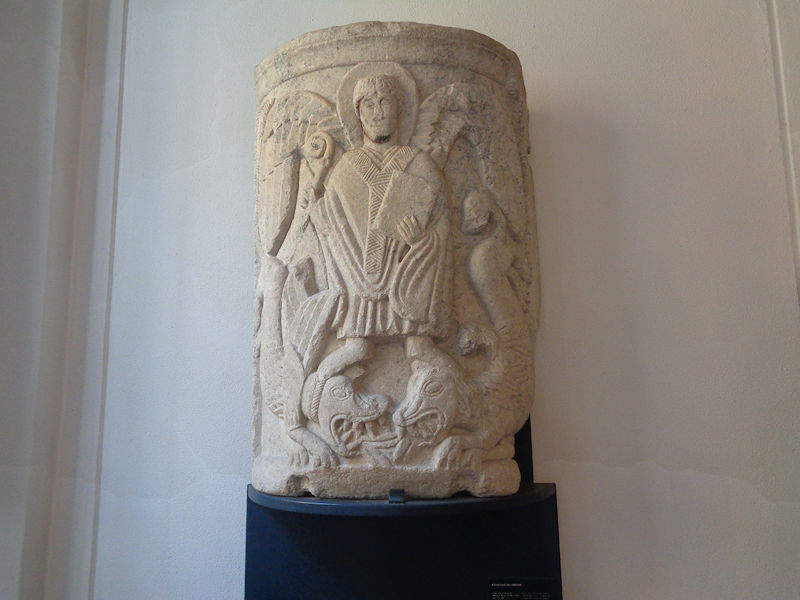
Lombard, betcha.


The 'after-lunch concert in the countryside', by Ambrosius Benson or his studio in the first half of the 16th century, reproducing a group of 10 panels on the same theme now in the Basel Kunstmuseum

A tapestry with a domestic scene and a little dog doing tricks

Dante Alighieri, by 'a Tuscan artist active in the first quarter of the 16th century'. Everybody thinks they can get to the essence of Dante.

Savonarola, by that same 'Tuscan artist active in the first quarter of the 16th century'. Everybody thinks they can get to the essence of Savonarola, and in this case they're probably right.

The Man, Baldassare Castiglione, the diplomat and author of the Il Cortegiano, the 1528 Book of the courtier (how to succeed as a Renaissance luminary and win friends especially the ladies), here attributed to Bernardino Campi from Cremona, dated to the early 1540s. Campi could never have seen Castiglione in person, but it's recognizably the same guy as in Raphael's famous portrait, dated to ca.1515.

We collect pictures of Judith with the head of Holofernes, comparing them all for raw emotion to the classic by Artemisia Gentileschi, and on a 1-10 scale this one, by Giovan Pietro Gnocchi, from Milan in the late 16th century, gets a 1.

But this gruesome but holy scene, 'The Benediction of the Decapitated Guy' by an Artista Lombardo in the late 17th century, is very Counter-Reformation.

The port of Como, by a Lombard artist active in the mid-19th century

On the upper floor we have the exhibition of modern and contemporary art . . .
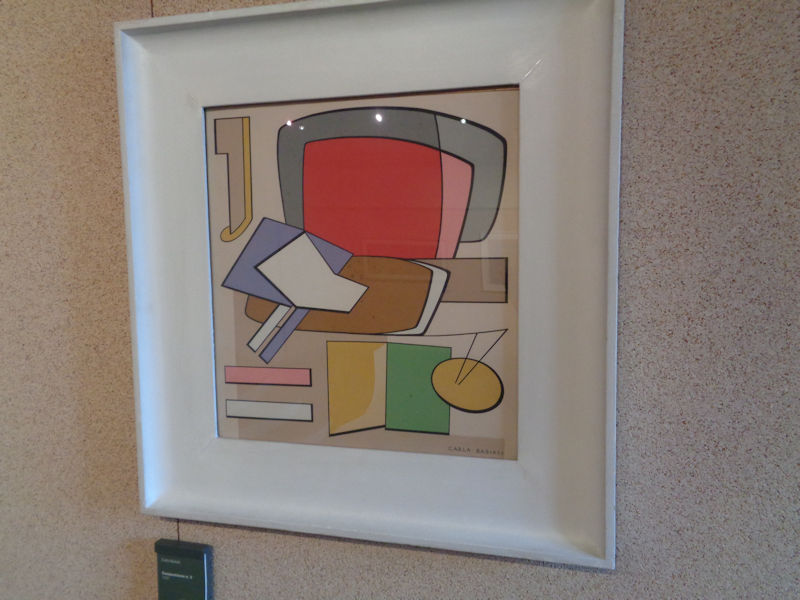
'Madonna Enthroned with Christ child and Saints Ambrose, Pantaleone, Donatus, and John the Baptist, with the donor kneeling in front'. Not really -- it's called 'Composizione n. 3' by Carla Badiali, 1936.

That's all we've got time for on this trip.

The Duomo di Como

If you're taking the shuttle to the casino and just can't wait a moment longer -- don't worry! You can Play on the Way.

The Porta Torre again. Following its absorption into the Milanese sphere of control, Como closely followed the destinies of Milan through the Visconti and Sforza eras, the French invasion and Spanish possession in the 16th century, and Austrian domination after 1714 until Napoleon's arrival in 1796.

Every city needs its Garibaldi -- in the Piazza Vittoria just outside the Porta Torre entrance to the city. Austrian rule was resumed after Napoleon's fall, but it was ended by Garibaldi's bold, nighttime liberation of Como after his Cacciatori ('the hunters of the Alps') defeated the Austrian army on 27 May 1859 at the Battle of San Fermo on the pass overlooking the town. The Palazzo Olginati, where Garibaldi himself stayed in 1866, is now the venue for the Museo Storico Giuseppe Garibaldi, inaugurated in 1932.

Now where did we leave the car?
Next: Back to Castiglione Olona, packing up in the Villa Puccini, and over the Simplon Pass.

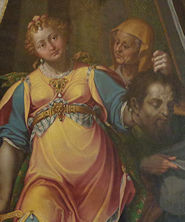 Dwight Peck's personal website
Dwight Peck's personal website












































































